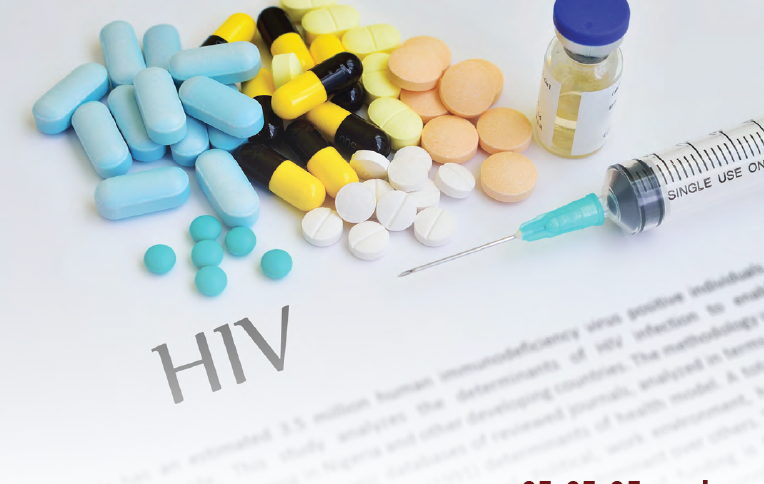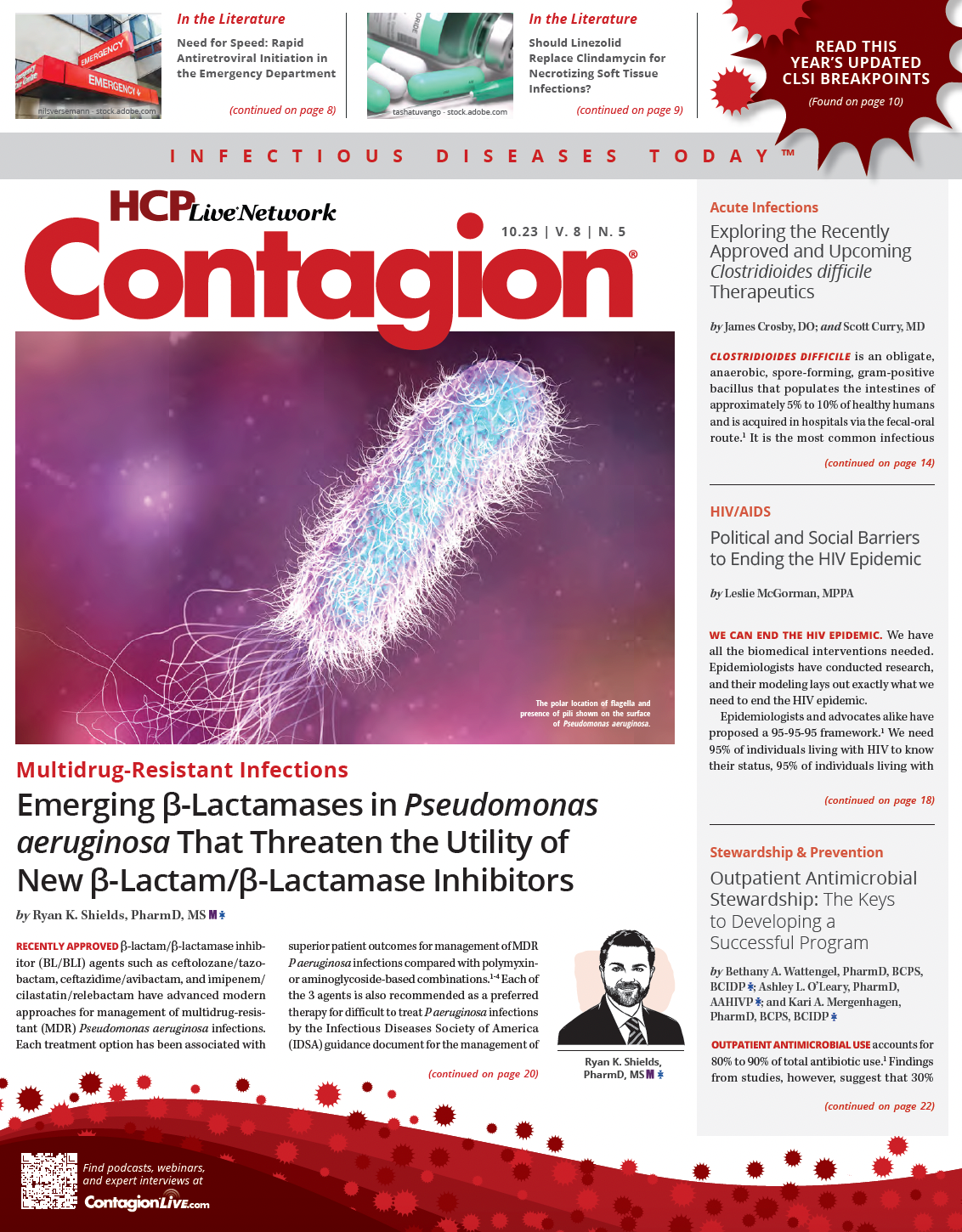We can end the HIV epidemic. We have all the biomedical interventions needed. Epidemiologists have conducted research, and their modeling lays out exactly what we need to end the HIV epidemic.
Epidemiologists and advocates alike have proposed a 95-95-95 framework.1 We need 95% of individuals living with HIV to know their status, 95% of individuals living with HIV to be durably retained in care, and 95% of individuals living with HIV to reach an undetectable status (also known by the moniker U = U).2 Approximately 1.2 million individuals in the United States have HIV.
At present, 87% of individuals living with HIV know their status, 50% are retained in care, and 57% have reached an undetectable status.3 Although we have a long way to go, investments in HIV testing, prevention, and treatment can get us to our goal.
TESTING, PREVENTION, AND TREATMENT
Testing is the gateway to both HIV prevention and management. Anyone who is at risk for HIV should test regularly. Those who attain negative test results need access to the range of prevention tools that already exist, and those living with HIV need to have the medical care necessary to reach an undetectable status. It should be straightforward.
BARRIERS TO ENDING THE HIV EPIDEMIC
Although testing, prevention, and treatment are the keys to achieving the 95-95-95 goal, significant challenges remain. Indeed, efforts to end the HIV epidemic in the United States have long been dogged by multiple social and political barriers.
These obstacles mean that each year, more individuals receive diagnoses of HIV and die from complications related to the disease. These barriers can be placed into 2 overlapping and interconnected categories: social barriers and political barriers.
SOCIAL BARRIERS
Everyone’s health is affected by the social context in which we live. These social determinants of health are the conditions in our environment that affect a wide range of health, functioning, and quality-of-life outcomes and risks. We know these determinants to include fundamental quality-of-life factors such as access to safe housing, transportation, education, and food.4 Although these determinants affect the health outcomes of individuals living with and at risk for HIV, there are 2 additional factors deserving of closer scrutiny: stigma and systemic racism.
What You Need to Know
Systemic racism and structural inequalities, such as racism and discrimination, contribute to the disproportionate impact of HIV on marginalized racial and ethnic communities. Individuals of color make up a significant proportion of the population but account for a higher number of individuals living with HIV.
Despite bipartisan efforts to combat HIV, there are significant political barriers, including inadequate federal funding, that hinder the progress of ending the HIV epidemic.
Expanding Medicaid plays a crucial role in ending the HIV epidemic, as it provides access to healthcare for a significant portion of individuals living with HIV.
Stigma
Stigma refers to the negative and discriminatory beliefs held by culture. These stigmas are often rooted in fear and misconceptions. And when it comes to HIV, the stigmas are wide ranging.
There is stigma related to the virus itself and stigma about how the virus is transmitted, such that it feels endemic to the fight against HIV.5 But there is also stigma around sex and sexuality and about sex work and drug use.6
All these stigmas discourage testing and treatment, and they perpetuate health disparities.
Systemic Racism
Structural inequalities, such as racism and discrimination, further contribute to the disproportionate impact of HIV on marginalized racial and ethnic communities. The HIV epidemic has long had racial disparities. Individuals of color make up approximately one-third of the population of the United States but account for two-thirds of the number of individuals living with HIV.7 There is nothing biologically unique about individuals of color that make them more susceptible to the virus, but there is a culture of white supremacy that causes these disparities and reinforces them.8
There is also well-justified medical mistrust.9 Historical instances of medical exploitation and unethical research have fueled deep-rooted mistrust in racial and ethnic minority communities. This mistrust, coupled with ongoing experiences of racism and discrimination within the health care system, hinders engagement and access to HIV prevention and management services.
POLITICAL BARRIERS
Efforts to end the HIV epidemic have long been bipartisan. President Donald Trump launched the federal Ending the HIV Epidemic in the U.S. initiative, and President Bill Clinton created the Ryan White HIV/AIDS Program. President George W. Bush created the US President’s Emergency Plan for AIDS Relief, and President Barack Obama released the first National HIV/AIDS Strategy. However, despite these very successful bipartisan efforts, significant political barriers exist.
Funding
As early as April 1983, barely 2 years into the HIV epidemic, Donald Francis, an early AIDS researcher and epidemiologist at the Centers for Disease Control and Prevention, said, “The inadequate funding to date has seriously restricted our work and has presumably deepened the invasion of this disease into the American population.”10 His words were not wrong then, and they’re not wrong today. Federal funding to end the HIV epidemic is inadequate. And yet despite inadequate funding, we have been on a positive trajectory. Today, there are fewer HIV infections, fewer HIV diagnoses, more people who know their status, more people linked to care, more people virally suppressed, and more people prescribed preexposure prophylaxis (PrEP) than in previous years (though disparities between groups remain).11
However, completely disregarding these positive bipartisan steps forward, Republican legislators on the US House Committee on Appropriations’ Subcommittee on Labor, Health and Human Services, Education, and Related Agencies recently put forward a bill that would slash funding for HIV-related programs. This includes the total elimination of funding for the Ending the HIV Epidemic in the US initiative.12
Ignoring Science, Legislating Morality
HIV policies often become entangled in political fights about morality, making it difficult to address the multiple syndemics associated with HIV. One way this arises is in the many attacks on reproductive rights and bodily autonomy. Since the US Supreme Court overturned the federally protected right to abortion, more than 25 million women live in states where abortion is banned or heavily restricted.13 And over just 2 legislative sessions, nearly half of all US states have enacted some type of ban on gender-affirming care.14 Together, these restrictions represent the latest frontier in stigmatizing health care and miring access to care in political rhetoric disingenuously disguised as moral concern.
Another way that lawmakers legislate stigma is by failing to support harm reduction programs. Harm reduction and syringe services programs work. They save lives and honor the dignity and humanity of individuals who use drugs.15
There are also 35 states that criminalize HIV. These laws were often created early in the epidemic and have not been updated as we have learned more about how HIV is transmitted.16
For example, individuals living with HIV have spent time in prison after spitting on someone. HIV is not found in saliva, and anyone with an undetectable status cannot pass HIV to anyone else.17 Many of these laws are rooted in stigma and do not consider the latest science.
There are legal challenges as well, such as the Braidwood Management Inc v Becerra case. The plaintiffs in that case, 2 Texas-based businesses, questioned the Affordable Care Act’s requirement that insurance cover preventive services at no additional cost to the person being insured. PrEP was added to that list in 2019, and the businesses argued that requiring them to pay for employee access to PrEP violated their religious beliefs because it encourages “homosexual behavior, prostitution, sexual promiscuity, and intravenous drug use.”18 Such homophobic comments about HIV and PrEP are certain to increase stigma.
A judge sided with the plaintiffs. His decision has been stayed pending appeal.
Failure to Expand Medicaid
Nearly 40% of individuals living with HIV have health care because of Medicaid, so Medicaid expansion plays a crucial role in ending the HIV epidemic.19 Individuals living with HIV in states that have not expanded Medicaid have reduced access to necessary care and treatment. Meanwhile, states that have expanded Medicaid eligibility have seen increased access to HIV testing, prevention tools, and management services.20
OVERCOMING THESE BARRIERS, ENDING THE HIV EPIDEMIC
From the earliest years of the epidemic to the present day, stigma, discrimination, and an inadequate federal response have posed significant obstacles to ending the HIV epidemic. Advancements in treatment and prevention have brought us as close as we’ve ever been to ending the HIV epidemic. We know what is needed, but success will require overcoming these social and political barriers. And that requires building the political will to address the social determinants of health and sustaining investment in programs that support HIV testing, prevention, and management.
References
1.AIDS United; Act Now: End AIDS. Ending the HIV Epidemic in the United States: A Roadmap for Federal Action. November 30, 2018. Accessed August 26, 2023. https://aidsunitedbtc.wpengine.com/wp-content/uploads/2021/05/Ending_the_HIV_Epidemic_in_the_United_States__A_Roadmap_for_Federal_Action.pdf
2.U=U Flagship Endorsements. Prevention Access Campaign. March 29, 2022. Accessed August 26, 2023. https://preventionaccesscampaign.kinsta.cloud/wp-content/uploads/2022/03/PAC_UU-Flagship-29-March-2022.pdf
3.U.S. statistics. HIV.gov. Accessed August 30, 2023. https://www.hiv.gov/hiv-basics/overview/data-and-trends/statistics/
4.Social determinants of health. US Department of Health & Human Services. Accessed August 30, 2023. https://health.gov/healthypeople/priority-areas/social-determinants-health
5.Anderson BJ. HIV stigma and discrimination persist, even in health care. AMA Journal of Ethics. December 2009. Accessed September 9, 2023. https://journalofethics.ama-assn.org/article/hiv-stigma-and-discrimination-persist-even-health-care/2009-12
6.Viswasam N, Schwartz S, Baral S. Characterizing the role of intersecting stigmas and sustained inequities in driving HIV syndemics across low-to-middle-income settings. Curr Opin HIV AIDS. 2020;15(4):243-249. Accessed September 2023. https://pubmed.ncbi.nlm.nih.gov/32487815/
7.Impact on racial and ethnic minorities. HIV.gov. Updated January 20, 2023. Accessed August 30, 2023. https://www.hiv.gov/hiv-basics/overview/data-and-trends/impact-on-racial-and-ethnic-minorities/
8.Randolph SD, Golin C, Welgus H, Lightfoot AF, Harding CJ, Riggins LF. How perceived structural racism and discrimination and medical mistrust in the health system influences participation in HIV health services for Black women living in the United States South: a qualitative, descriptive study. J Assoc Nurses AIDS Care. 2020;31(5):598-605. doi:10.1097/JNC.0000000000000189
9.Bogart LM, Ransome Y, Allen W, Higgins-Biddle M, Ojikutu BO. HIV-related medical mistrust, HIV testing, and HIV risk in the National Survey on HIV in the Black Community. Behav Med. 2019;45(2):134-142. doi:10.1080/08964289.2019.1585324
10.A plea for more funding. PBS. Accessed August 26, 2023. https://www.pbs.org/wgbh/pages/frontline/aids/docs/francisplea.html
11.America's HIV Epidemic Analysis Dashboard (AHEAD). National Progress. Accessed September 15, 2023. https://ahead.hiv.gov/
12. Making Appropriations for the Departments of Labor, Health and Human Services, and Education, and Related Agencies for the Fiscal Year Ending September 30, 2024, and for Other Purposes, 118th Cong, 1st Sess (2023). Accessed August 26, 2023. https://docs.house.gov/meetings/AP/AP07/20230714/116252/BILLS-118--AP--LaborHHS-FY24LHHSSubcommitteeMark.pdf
13. Mulvihill G, Kruesi K, Savage C. A year after fall of Roe v. Wade, 25 million women live in states with abortion bans or restrictions. PBS. June 22, 2023. Accessed September 11, 2023. https://www.pbs.org/newshour/politics/a-year-after-fall-of-roe-v-wade-25-million-women-live-in-states-with-abortion-bans-or-restrictions
14. Map: attacks on gender affirming care by state. Human Rights Campaign. Updated August 22, 2023. Accessed September 11, 2023. https://www.hrc.org/resources/attacks-on-gender-affirming-care-by-state-map
15. Syringe services programs (SSPs). Centers for Disease Control and Prevention. Updated August 21, 2023. Accessed August 30, 2023. https://www.cdc.gov/ssp/index.html
16. HIV and STD criminalization laws. Centers for Disease Control and Prevention. Updated March 3, 2023. Accessed August 30, 2023. https://www.cdc.gov/hiv/policies/law/states/exposure.html
17. Satta M. Spitting at science: the unjustified criminalization of spitting while HIV-positive.Bill of Health. February 25, 2019. Accessed August 30, 2023. https://blog.petrieflom.law.harvard.edu/2019/02/25/spitting-at-science-the-unjustified-criminalization-of-spitting-while-hiv-positive/
18. Braidwood Management Inc v Xavier Becerra,92 F Supp 1755 (ND Tex 2022). Accessed August 30, 2023. https://affordablecareactlitigation.files.wordpress.com/2022/09/gov.uscourts.txnd_.330381.92.0_1.pdf
19. Dawson L, Kates J, Roberts T, Chidambaram P. Medicaid and people with HIV. KFF.March 27, 2023. Accessed August 30, 2023. https://www.kff.org/hivaids/issue-brief/medicaid-and-people-with-hiv/
20. Dawson L, Kates J. People with HIV in non-Medicaid expansion states: who could gain coverage eligibility through Build Back Better or future expansion? KFF.February 15, 2022. Accessed August 30, 2023. https://www.kff.org/hivaids/issue-brief/people-with-hiv-in-non-medicaid-expansion-states-who-could-gain-coverage-eligibility-through-build-back-better-or-future-expansion/


